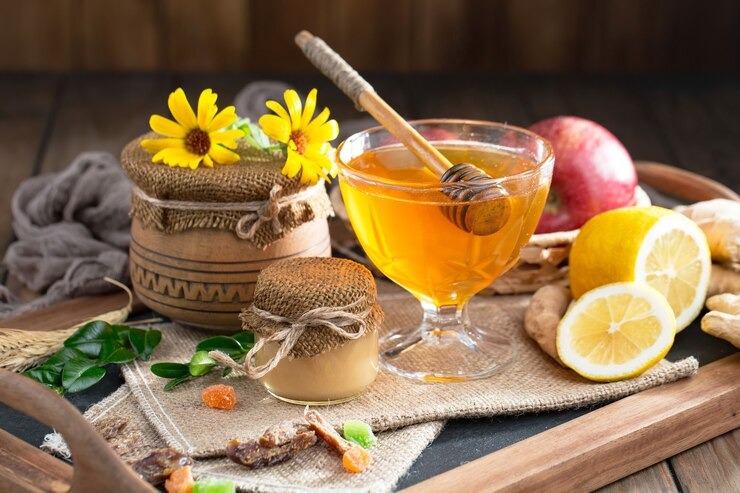Winter season having chilly winds. The nights are longer and days are shorter. According to Ayurveda recognize the three doshas that is vata, pita and kapha. Each dosha is associated with specific qualities and elements and maintaining the balance of our body. A proper balance of the doshas is essential for overall physical and mental health. In the winter season the doshas get imbalanced due to environmental changes.
In winter season the skin became dryer and the skin appears to age. The Common symptoms include dryness, cracking, dullness, and roughness of the skin. Moisturizing the body becomes important in winter season we can use coconut oil or olive oil for it. During the winter season, the Vata dosha tends to be more predominant Vata is associated with qualities like cold, dry, light, and erratic.
DOSHA BASED SKIN TYPES
-
Vata Skin Type
The skin is to be drier and rougher. It requiring moisturizing with coconut oil. For these skin Ashwagandha supplements can also give.
-
Pitta Skin Type
The skin is more prone to the allergies and a wide range of skin disorders. For these skins cooling treatment is done with Chandana, Kumari (alovera) etc
-
Kapha Skin Type
In winter season kapha dosha gets m balanced this will makes to increase oiliness and dullness this might leads to blackheads, pimples, or cystic acne.
TYPES OF SKIN IN POPULAR TERMS
-
Dry Skin
Dry skin lacks the necessary lipids to keep moisture in and provide a protective barrier against external influences. As a result of the barrier’s function is disturbed. Dry skin comes in a variety of degrees of severity and kinds that aren’t always easily distinguishable. The degree of sweat and the water supply into the deeper layers of the skin determine the skin’s moisture.
-
Normal Skin
The term ‘normal’ refers to skin that is well-balanced. People with this skin type may have oily qualities in their T-zone, which includes the forehead, nose, and chin. Despite this, sebum and skin moisture are in equilibrium. The skin would be neither too dry nor excessively greasy under these circumstances. A typical skin type has narrow pores and a soft, velvety, and smooth texture, allowing for good blood circulation.
-
Oily Skin
The term “oily” is frequently used to describe a kind of skin that produces more sebum. Oily skin is frequently accompanied by larger, visible pores that shine brightly. A light complexion is one of the other characteristics. The blood vessels may not be seen in such circumstances. Blackheads and whiteheads, as well as numerous forms of acne, are common in oily skin. Mild acne can be present on the face, as well as the throat, shoulders, and chest.
-
Combination Skin
These skin types have a wide range of T-zone and cheek features, ranging from a very narrow zone to a significantly enlarged area. Sebum overproduction triggers the oilier parts of the mixed skin type. The combination skin might be dried out due to a lack of adequate sebum and a lipid deficit.
The ayurvedic skin treatment are based on the types of skin
AYURVEDIC TREATMENT FOR SKIN IN WINTER SEASON
Dry Skin
- Doing regular moisturize with oils such as Eladi tailam or Eladi keram to create a protective layer on the skin.
- Gentle Cleansing: Avoid harsh, drying cleansers. Use hydrating, soap-free products instead.
- Avoid Hot Showers: Hot water can strip natural oils from the skin, so opt for lukewarm water instead.
Oily Skin
- Light Moisturization: Use light, non-comedogenic oils like jojoba oil or neem oil.
- Diet: Include warming spices in your diet and avoid too many oily or heavy foods.
Combination Skin
- Balanced Care: Use a heavier moisturizer on dry areas and a lighter one on oily areas.
- Spot Treatment: Treat different areas of your face according to their needs – more hydration for dry patches, and gentle care for oily zones.
Sensitive Skin
- Cooling Hydration: Use moisturizers that are hydrating but not too heavy, like coconut oil or Kumari(alovera)
- Soothing Ingredients: Look for skincare products with calming ingredients like sandalwood or rose.
Normal Skin
- Regular Moisturizing: Use a daily moisturizer to maintain skin’s balance.
- Gentle Cleansing: Stick to a mild cleanser to avoid stripping the skin of its natural oils.
These are the some ayurvedic treatment for skin in winter season
GENERAL TIPS IN WINTER SEASON
Dietary Adjustments
- Vata: Focus on warm, cooked, nourishing foods. Include healthy fats and oils, root vegetables, and spices like Sunthi or Adrak, Tvak, and
- Pitta: While Pitta is less likely to be aggravated in winter, maintain a balance with warm but not overly hot or spicy foods. Favour Madura, Tikta, and Kashaya rasa.
- Kapha: Since Kapha can increase in winter, incorporate light, warm, and dry foods. Think of cooked grains like barley and millet, and spices like Haridra, Maricha, and Jeeraka to stimulate digestion.
Lifestyle Practices
- Sleep: Vata types need plenty of rest but should avoid sleeping during the day. Kapha, which can lead to sluggishness, should avoid excessive sleep, especially during the day.
- Yoga and Breathing: Practices like yoga can be very beneficial. Vata types should focus on slow, grounding poses, while Kapha types may benefit from more vigorous activities to keep their energy levels up.
- Pranayama (breath control exercises) can be particularly helpful. Nadi Shoshana (alternate nostril breathing) is good for balancing Vata and Kapha
